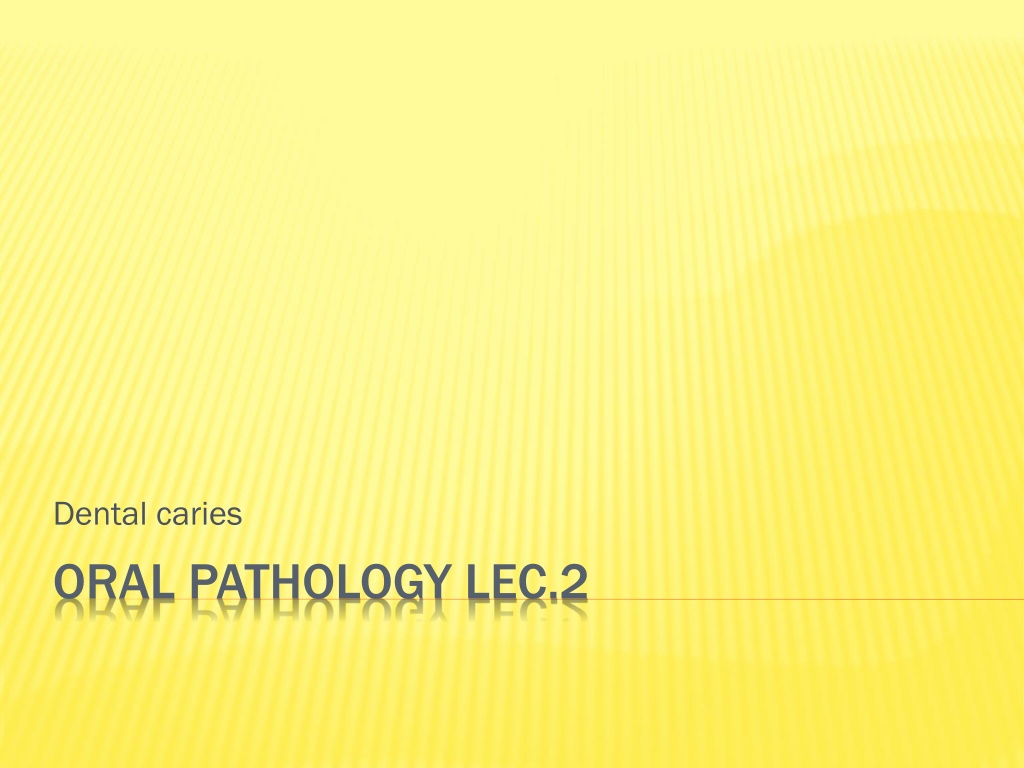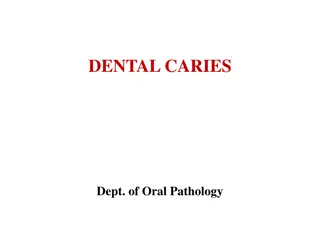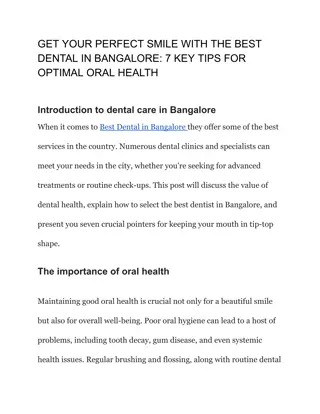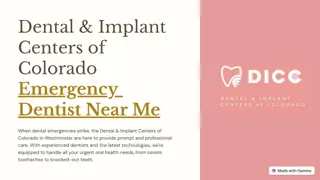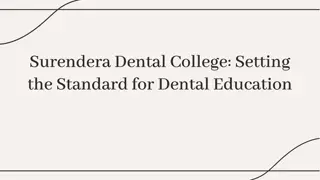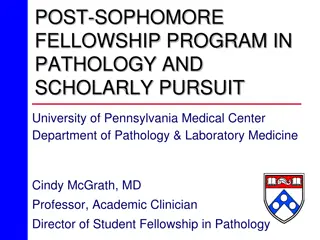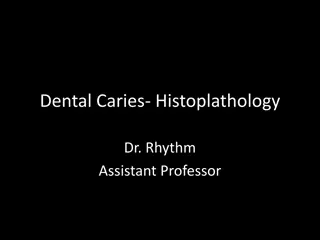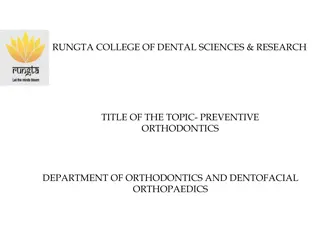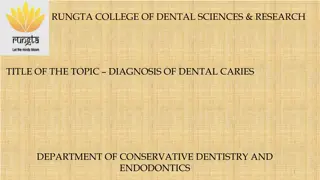Understanding Dental Caries: Pathology and Etiopathogenesis
Dental caries is a microbial disease affecting tooth structure, leading to demineralization and cavity formation. It is a complex process with multifactorial causes, involving theories like Miller's acidogenic theory. Factors like carbohydrates, microorganisms, acids, and dental plaque play a role in its development.
Download Presentation

Please find below an Image/Link to download the presentation.
The content on the website is provided AS IS for your information and personal use only. It may not be sold, licensed, or shared on other websites without obtaining consent from the author. Download presentation by click this link. If you encounter any issues during the download, it is possible that the publisher has removed the file from their server.
E N D
Presentation Transcript
Dental caries ORAL PATHOLOGY LEC.2
DENTAL CARIES Dental caries is defined as a progressive irreversible irreversible microbial disease affecting the hard parts hard parts of tooth exposed to the oral environment, resulting in demineralization the inorganic constituents inorganic constituents and dissolution the organic constituent, thereby leading to a cavity formation. progressive demineralization of dissolution of
It is a complex, continuous, dynamic biological process of tooth decay with multifactorial etiology. etiology. multifactorial
THEORIES OF THEORIES OF ETIOPATHOGENESIS ETIOPATHOGENESIS Miller s acidogenic theory Proteolytic theory Proteolysis-chelation theory Sucrose chelation theory.
MILLERS MILLER S ACIDOGENIC ACIDOGENIC THEORY THEORY WD Miller s chemoparasitic theory states: Dental decay is a Dental decay is a chemoparasitic chemoparasitic process consisting of two stages, the decalcification of consisting of two stages, the decalcification of enamel, which results in its total destruction enamel, which results in its total destruction and the decalcification of dentin as a and the decalcification of dentin as a preliminary stage, followed by dissolution of the preliminary stage, followed by dissolution of the softened residue. softened residue. process
FACTORS RESPONSIBLE FOR MILLERS THEORY FACTORS RESPONSIBLE FOR MILLER S THEORY Role of carbohydrates Role of microorganisms Role of acids Role of dental plaque.
ROLE OF CARBOHYDRATES Food act as substrates for microorganisms of dental plaque, which form acids, thereby causing dental caries. Other substances may affect microflora in negative way thus protecting the tooth from caries. Carbohydrates is main cause of dental caries. There is considerable increase in caries incidence after exposure of modern civilization to refined foods.
CARIOGENICITY CARIOGENICITY OF CARBOHYDRATE VARIES OF CARBOHYDRATE VARIES WITH : WITH : Frequency of ingestion Frequency of ingestion: The risk of caries incidence increases greatly if carbohydrates are taken repeatedly in between two major meals. It provides an almost constant supply of carbohydrate to the plaque bacteria for fermentation and subsequent production of acids. Chemical Chemical composition composition : The carbohydrates in the form of glucose, sucrose and fructose, etc. rapidly diffuse into the plaque due to their low molecular weight and therefore easily available for fermentation by plaque bacteria; Sucrose is utilized by Streptococcus mutans to synthesize an extracellular insoluble polysaccharide (dextran) with the help of glucosyl transferase enzyme. Dextran helps the plaque to adhere firmly onto the tooth surface and helps a direct contact between the acids liberated by microorganisms and the tooth, thus causing demineralization. Thus, sucrose is most potent cariogenic substance.
Physical form Physical form : Sticky, solid carbohydrates are more cariogenic than other forms Route of Route of administration administration Presence of other food constituents Presence of other food constituents
ROLE OF MICROORGANISMS ROLE OF MICROORGANISMS Caries is caused by acid resulting from action of microorganisms on carbohydrates. Bacteria that can produce acids, particularly lactic acid, from the substrate of host s diet and can tolerate very low pH (<5) are suspected of initiating caries.
LOCALIZATION OF ORAL FLURA IN DENTAL CARIES Location Location Microorganism Microorganism Pit and fissure Pit and fissure Streptococcus Streptococcus mutans mutans Lactobacillus species Lactobacillus species Smooth surface caries Smooth surface caries Streptococcus Streptococcus mutans mutans Root caries Root caries Actinomycosis Actinomycosis viscosus viscosus Actinomycosis Actinomycosis naeslundii naeslundii Other filamentous rod Other filamentous rod Streptococcus Streptococcus mutans mutans Streptococcus Streptococcus salivarius salivarius Streptococcus Streptococcus sanguis sanguis Deep dentinal caries Deep dentinal caries Lactobacillus species Lactobacillus species Actinomycosis Actinomycosis viscosus viscosus Actinomycosis Actinomycosis naeslundii naeslundii Streptococcus Streptococcus mutans Other filamentous rod Other filamentous rod mutans
STREPTOCOCCUS MUTANS: The role of S. The role of S. mutans initiation of caries on the following basis: initiation of caries on the following basis: It increases the amount of sticky plaque as it is capable of producing extracellular polysaccharides. It generates acid rapidly from sucrose . It multiply in abundance in low pH plaque thereby colonizing and increasing the plaque bulk. It provides a favorable substrate for other cariogenic microorganisms. mutans has been proved for the has been proved for the
PROGRESSION OF DENTAL CARIES: The organisms responsible for progression of the lesion are usually present in the advancing front of the dentinal caries. These are mostly facultative and strict anaerobes in advanced dentinal caries. Streptococcal species in deep dentinal caries and root caries and Lactobacillus casei and acidophilus in dentin.
ROLE OF ACIDS: ROLE OF ACIDS: Acids play most important role in the pathogenesis of dental caries. The pH 5.5 is called critical pH because below this pH demineralization of tooth substance begins. The rapid fall in pH is mainly due to microorganisms metabolizing food substances and producing acids. This fall in pH depends upon amount of diffusible carbohydrates, nature of microorganisms and rate of diffusion of microorganism.
The rise in pH is slower and it depends upon ability of saliva to neutralize acids and diffusibility of acids out of plaque. The acids produced due to enzymatic breakdown of the sugar and the acids formed are chiefly lactic acid and butyric acid. Other acids which are produced are acetic acid, propionic acid, glutamic acid, aspartic acid. These acids cause demineralization of inorganic portion (initially enamel and later dentin) and eventually cause tooth decay.
ROLE OF DENTAL PLAQUE ROLE OF DENTAL PLAQUE Dental plaque is a general term for the diverse microbial community (predominantly bacteria) found on the tooth surface, embedded in a matrix of polymers of bacterial and salivary origin.
The dental plaque is consists of: The dental plaque is consists of: Salivary components such as mucin. Desquamated epithelial cells. Microorganisms. Plaque is found on uncleaned tooth surfaces and appears as tenacious, thin film which may accumulate within 24 to 48 hours.
GV GV Black follows: follows: The gelatinous plaque of the caries fungus is a thin, transparent film that usually escapes observation, and which is revealed only by careful search. It is not the thick mass of materia alba found on the teeth, nor is it the whitish gummy material known as sordes, which is often prominent in fevers and often present in the mouth in smaller quantities in the absence of fever. Black(1899)defined (1899)defined cariogenic cariogenic plaque as plaque as
THE DEVELOPMENT OF DENTAL PLAQUE: Pellicle formation Attachment of singlebacterial cells(0 4hours) Growth of bacteria leadingto formation of microcolonies(4 24hours) Microbial succession and co-aggregation leading to increased species diversity concomitant with continued growth of microcolonies(1 14days) Mature plaque(2 weeks or older).
pellicle: pellicle: This form is a glycoprotein that is derived from the saliva and is adsorbed on tooth surface and the bacterial colonization takes place (the pellicle serves as a nutrient for plaque microorganisms). Breaks down in the homeostasis and imbalances in the microflora can occur which predispose a site to disease.
The filamentous organisms grow in long interlacing threads and have the property of adhering to smooth enamel surfaces. Smaller bacilli and cocci become entrapped in this reticular meshwork. The adhering property and acidogenic property of streptococci and aciduric property of lactobacilli help in further development of cariogenicity of the dental plaque.
PROTEOLYSIS THEORY PROTEOLYSIS THEORY This theory suggests the role of the proteolysis of the organic components of the tooth as an initial process than the actual demineralization and dissolution of inorganic substances.
PROTEOLYSIS PROTEOLYSIS CHELATION CHELATION THEORY THEORY The proteolytic chelation theory suggests that the caries is caused by simultaneous events of proteolysis and chelation. Proteolysis Proteolysis is destruction of the organic portion of the tooth by the proteolytic microorganisms. Chelation Chelation is removal of calcium by forming soluble chelates by biologic chelators such as certain citrates, amino acids, phosphatases, tartrates, oxalates and enzymes, etc.
It is postulated that oral bacteria attack organic component of enamel (proteolysis) and that the breakdown products have chelating ability and this dissolves the tooth minerals. This results in formation of soluble chelates with the minerals of the enamel and thereby decalcifies it at a neutralor even at an alkaline pH(Chelation).
SUCROSE SUCROSE CHELATION CHELATION THEORY THEORY This theory states that if there is a very excessive concentration of sucrose in the mouth of a caries active individual, there can be formation of complex substances like calcium saccharates and calcium complexing intermediaries, etc. by the action of phosphorylating enzymes. These complexes cause release of calcium and phosphorus ions from the enamel and thereby resulting in tooth decay.
SECONDARY CONTRIBUTING FACTORS IN SECONDARY CONTRIBUTING FACTORS IN DENTAL CARIES DENTAL CARIES Saliva Saliva Salivary flow rate pH and buffering capacity Viscosity Antibacterial substances Teeth Teeth Structural composition Morphology Arrangement in the arch Presence of dental appliance Diet Diet Physical nature Composition Hereditary Hereditary
SALIVA Decrease or lack of salivary secretion results in increased rate of dental caries and rapid destruction of tooth as the cleaning or flushing of the bacterial deposits is hampered.
In saliva, the chief buffer systems are the bicarbonate ions and phosphate ions. High concentrations of bicarbonate ions neutralize the acids produced by the cariogenic bacteria. Urea secreted in saliva helps in the formation of ammonia by action of the plaque microorganisms. Ammonia acts as buffer in maintaining the salivary pH.
TEETH Teeth are usually susceptible to caries during first 2 years after eruption for completion of calcification after eruption. Concentration of higher number of minerals in the enamel surface, renders it more resistant to decay. Hypomineralized and hypoplastic enamel has more incidences of caries. Increased permeability of the enamel surface increases the risk of the caries activity.
Teeth which have high percentage of fluoride are more resistant to caries process. Pits and narrow fissures allow retention of food debris and thus are prone to development of decay. These areas are also not easily approachable to routine oral hygiene practices. The most susceptible permanent teeth are the mandibular first molars followed by the maxillary first molars and the mandibular and maxillary molars.
CLASSIFICATION: Clinical classification Anatomical classification Nature of attack Progression of caries Based on tissue involved
CLINICAL CLASSIFICATION OF CARIES According to the stage of lesion progression According to the stage of lesion progression: Noncavitated Noncavitated lesion lesion Cavity. Cavity. According to the severity of the disease: According to the severity of the disease: Acute caries(active) Acute caries(active) Chronic caries Chronic caries (slowly (slowly progression) Stabilized caries (arrested Stabilized caries (arrested). According to clinical manifestation: According to clinical manifestation: White spot lesion White spot lesion :macula :macula caroisa Superficial caries: Caries Superficial caries: Caries superficialis Medium caries: Caries Medium caries: Caries media Deep caries: Caries Deep caries: Caries profunda profunda Secondary caries: Caries Secondary caries: Caries secundaria progression) caroisa superficialis media secundaria.
ANATOMICAL CLASSIFICATION OF CARIES According to anatomical depth of the defect According to anatomical depth of the defect: Enamel caries Enamel caries Dentin caries Dentin caries Cementum Cementum caries caries According to location of the lesion According to location of the lesion: Pit and Pit and fissure fissure caries caries Occlusal Occlusal Buccal Buccal or or lingual Proximal Proximal Buccal Buccal or lingual lingual pit pit Smooth surface Smooth surface caries caries or lingual surface surface Root caries Root caries According to intensively of caries within the dentition: According to intensively of caries within the dentition: Single lesion Single lesion Multiple Multiple lesions lesions Systemic destruction Systemic destruction.
DEPENDING ON NATURE OF ATTACK Primary caries (Incipient, initial): First attack on tooth surface Secondary caries (Recurrent):Caries occurring at the margins or walls of existing restorations.
DEPENDING ON THE PROGRESSION OF THE CARIES Acute: Acute: It rapidly invading process that involves several teeth. Lesions are soft and light colored. Usually pulp is involved at the early stage. Rampant caries Nursing bottle caries Radiation caries. Chronic: Chronic: These lesions are long standing and fewer in number.
SMOOTH SURFACE CARIES: Proximal Caries Proximal Caries: It takes 3 to 4 years to manifest clinically as loss of enamel transparency resulting in opaque chalky region (white spot). Spots are located on the outer surface of enamel between contact point and height of free gingival margin.
The caries penetrates the enamel, the enamel surrounding the lesion assumes bluish white appearance which is usually apparent as laterally spreading caries at the dentinoenamel junction. Caries does not initiate below free gingival margin.
Cervical, Cervical, Buccal It usually extends from the area opposite the gingival crest occlusally to the convexity of the tooth surface. It extends laterally towards the proximal surfaces and on occasion extends beneath the free margin of the gingiva. It usually occurs in cervical area and the typical cervical lesion is a crescent shaped cavity beginning as slightly roughened chalky area which gradually becomes excavated. Buccal, Lingual or Palatal Caries: , Lingual or Palatal Caries:
HISTOPATHOLOGY OF SMOOTH SURFACE CARIES: Enamel Changes Enamel Changes : The earliest changes are loss of the inter-prismatic or interrod substance of enamel with increased prominence of the rods. The roughening of the ends of the enamel rods, suggest that the prisms may be more susceptible to early attack. Another change in early enamel caries is the accentuation of the incremental striae of Retzius.
Enamel consists of crystals of hydroxyapatite packed tightly together in orderly arrangement. Each crystal is separated from its neighbors by tiny intercrystalline spaces or pores. The spaces are filled with water and organic material. When enamel is exposed to acids produced by dental plaque, minerals is removed from the surface of the crystals which shrinks in size. The intercrystalline spaces enlarge and the tissue becomes more porous. At this stage the carious lesion can be detected clinically and called white spot lesion .
Ultrastructural studies suggest preferential dissolution initially along prism boundaries, but there is also a diffuse demineralization with an increase in intercrystallite distance affecting areas both within and between the prisms. These intercrystallite spaces presumably reflect the variation in pore volume in different areas of the lesion; changes in crystal structure are thought to be due to both demineralization and reprecipitation of mineral.
As the process advances and involves deeper layers of enamel, it will form triangular or actually a cone-shaped lesion with apex towards the dentinoenamel junction and the base towards the surface of the tooth.
